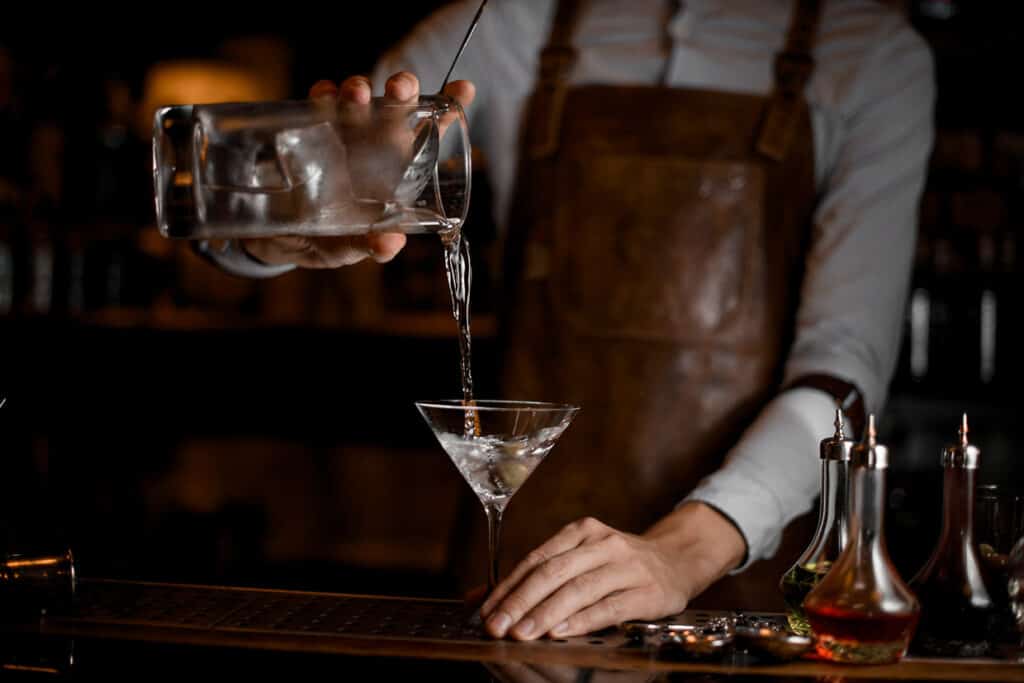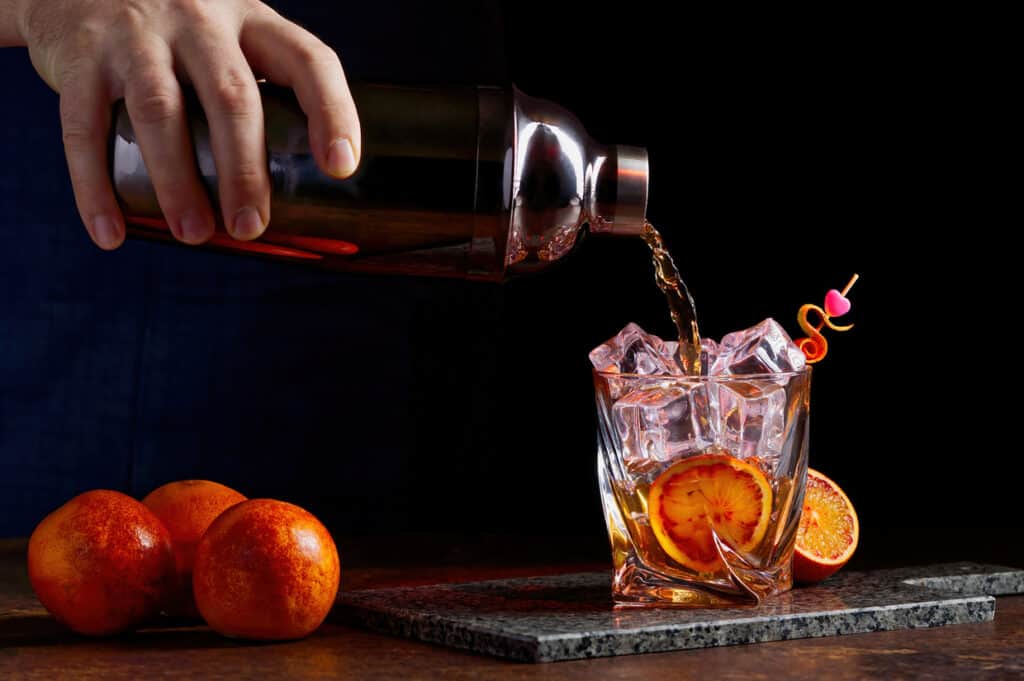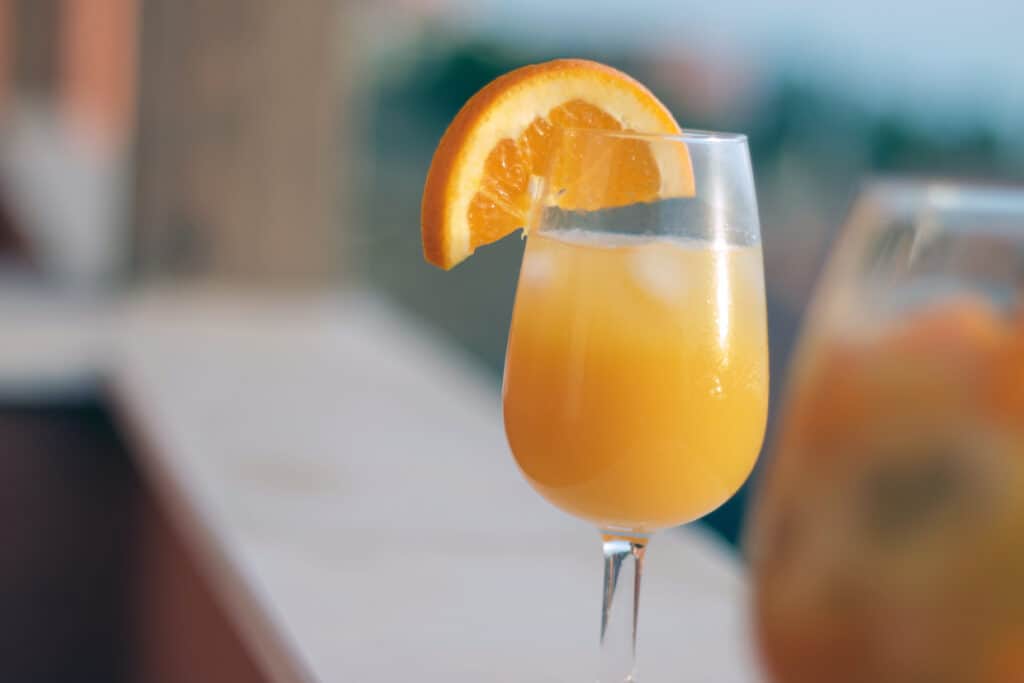James Bond famously ordered his favorite cocktail, the classic martini, “shaken, not stirred.” These are two ways to prepare a cocktail, and there’s more to them than just combining ingredients. How the components are mixed changes the drink’s texture, temperature, flavor and appearance.

Shaken, not stirred, is the personal preference of James Bond for his vodka martini cocktail in the book and movie versions. Author Ian Fleming’s Agent 007 requests the bartender prepare a shaken martini by vigorously shaking the ingredients with ice in a cocktail shaker, not stirring them together. The difference affects the texture, temperature, flavor and appearance of the drink.
These two drink preparation methods — shaking in a cocktail shaker or stirring in a mixing glass — are part of a trio. The third method, called building, refers to simply pouring ingredients into a glass, and letting them mix together on their own.
Each of these three methods creates different types of cocktails. It’s important for cocktail enthusiasts and professional bartenders alike to learn the key differences and when to use them. Every classic cocktail has its own method of preparation.
The 3 methods of preparing cocktails
All three methods of mixing drinks combine the ingredients but in different ways. Here are the key differences:
- Shaking: When drinks are shaken with ice, the friction of the vigorous shaking of liquid against the ice causes it to melt. The resulting water causes dilution of the alcohol, reducing the cocktail’s strength.
- Stirring: Stirring cocktails is gentler than shaking. The ingredients are combined in a mixing glass and slowly stirred with a long spoon called a bar spoon. The slower movement causes less dilution, allowing strong drinks to remain robust and undiluted.
- Building: The third way is the simplest way to make cocktails. In fact, you’ve probably built a cocktail before without realizing it. Built-in-the-glass drinks are quick, efficient cocktails with just two or three ingredients.
“I prefer to stir cocktails as opposed to shaking them. Shaking a cocktail with ice can create tiny ice shards in the drink that dilute the flavor more quickly. Stirring cocktails allows you to taste the full flavor of the ingredients.”
— Gen La Rocca, Two Cloves Kitchen

Shaken cocktails
When ingredients are shaken with ice, the ingredients cause friction and become ice-cold. The friction can cause dilution but also can make the drink cloudy.
In a proper martini, cloudiness is an undesirable effect, which is why they are shaken not stirred. But in other cocktails, shaking is the perfect way to prepare the drink. However, unlike savory martinis, sweet dessert martinis made with liqueurs are usually shaken.
When a drink is shaken too much, ice shards float to the top of the drink. These ice chips give the drink the nickname of bruised, as the tiny ice pieces melt and change the taste of the cocktail.
Some drinks are made with egg whites or cream, such as the whiskey sour and the white Russian, respectively. The friction of shaking helps to whip these ingredients. In the case of egg whites, the drink develops a layer of foamy, bubbly froth. With cream, the drink attains a thicker silky texture, like a lightly whipped cream.
Some drinks are a real workout for the arms. The inventor of the Ramos gin fizz, Henry Charles Ramos, notoriously had his bartenders shake each of these creamy gin cocktails for 12 minutes apiece. More shaking infuses more tiny air bubbles into the ingredients, allowing a thick, fluffy foam to form on top of the drink.
The drink is then strained into the cocktail glass — the strainer holds back the ice, allowing only the liquid to pass through, landing over fresh ice. If the resulting drink isn’t served on the rocks, the cocktail glass is usually chilled in the freezer.
If a two-piece Boston shaker is used, a separate strainer is needed, such as a Hawthorne strainer with a spring for nestling it inside the glass. With a three-piece shaker known as the cobbler shaker, a strainer is built-in, making another strainer unnecessary.
Most professional bartenders, however, prefer the two-piece shaker and a strainer with more and larger holes, as they yield better pours. Common shaken cocktails include:
- margarita
- daiquiri
- espresso martini
- sidecar
- shot recipes

Stirred cocktails
Spirit-forward cocktails are usually stirred. In a stirred drink, the most prominent flavor is the booze, such as a whiskey-based Manhattan cocktail.
Even though Bond’s preference is for his martinis to be shaken not stirred, these strong drinks are best prepared stirred. They usually contain a main spirit or two, fresh citrus juice or a sweetener like simple syrup.
Stirred cocktails are usually prepared in a mixing glass, which is a small pitcher with a spout. When a spirit-strong cocktail is stirred slowly, the ice melts less quickly, while still chilling the ingredients. Like shaken drinks, stirred drinks are usually strained over fresh ice or into a chilled cocktail glass.
Common stirred cocktails include:
- martini
- old-fashioned
- negroni
- boulevardier

Built cocktails
The last method entails building the drink directly in the cocktail glass. Ingredients are added to the drinking vessel, meaning no shaking or stirring is required.
These minimalist drinks usually include just two or three ingredients. The most common combinations are a base spirit with soda, such as a gin and tonic. Other built cocktails can include muddled ingredients, like herbs or fruit, such as a whiskey smash or mint julep.
When mixers are used, the mixers are already combined, making building a drink easy. The bloody Mary is a great example — vodka is simply topped with a pre-mixed bloody Mary mix of tomato juice, lemon juice and spices.
Common built cocktails include:
- rum and Coke
- ranch water
- Americano
- Scotch and soda
- mimosa
Combining the methods
It’s important to note that the three methods for mixing cocktails can be combined. For example, a base could be shaken or stirred, strained into a glass and then topped with a built layer of bubbles, like ginger beer or club soda, such as a Moscow mule. The additions are often non-alcoholic ingredients, but they can include alcohol.
Floats are a layered effect created by slowly pouring liquor over the back of a bar spoon. The lighter weights and densities of alcohol-based ingredients will float to the top of heavier ones, creating a beautiful layered look. The New York Sour is known for its float of red wine. Another famous layered cocktail is the Pousse-Cafe, which has a rainbow effect.
Garnishes like a lemon twist and other flavorings like bitters would also be added after the drink is in the glass. Bitters especially add fragrance to the very top of the drink once the cocktail is almost complete. The nose would detect a few drops or dashes of Angostura or orange bitters, adding extra fragrance to enhance the flavor of the beverage.
Which method to use
The general rule of thumb when choosing a method comes down to how strong the cocktail is, the desired texture and the ideal temperature. Personal preference too, is key — especially in the case of James Bond and his shaken not stirred drinks. If you have a favorite way to prepare your martinis, stick with it.
Based in Charlotte, N.C., Susannah Brinkley Henry is the cocktail content creator behind the blog Feast + West. Her work has been featured in Southern Living, Oprah Daily, Buzzfeed and more. In 2019, her website was a finalist in the Saveur Blog Awards for Best Entertaining Blog. As a professional graphic designer, photographer, writer and recipe developer, Susannah helps home bartenders and drink enthusiasts level up their cocktail skills.